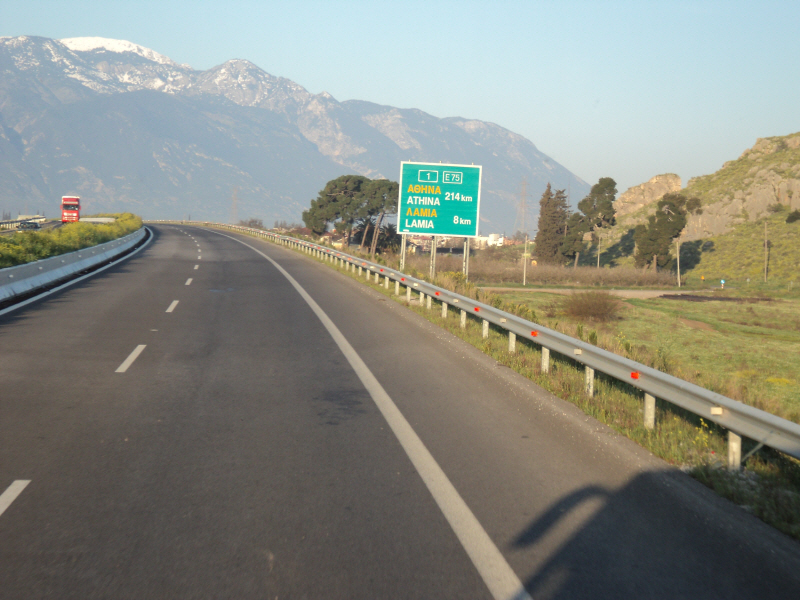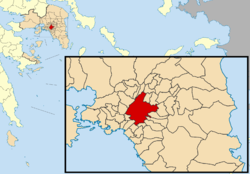Athens
| Athens Αθήνα Athīna | |
|---|---|
 From upper left: the Acropolis, the Hellenic Parliament, the Zappeion, the Acropolis Museum, Monastiraki Square, Athens view towards the sea. | |
| Location | |
| Coordinates | |
| Government | |
| Country: | Greece |
| Periphery: | Attica |
| Peripheral unit: | Central Athens |
| Districts: | 7 |
| Mayor: | Giorgos Kaminis (PASOK) (since: 29 December 2010) |
| Population statistics (as of 2001[1]) | |
| Urban | |
| - Population: | 3,130,841 |
| - Area: | 411.717 km2 (159 sq mi) |
| - Density: | 7,604 /km2 (19,695 /sq mi) |
| Metropolitan | |
| - Population: | 4,013,368 |
| - Area: | 2,928.717 km2 (1,131 sq mi) |
| - Density: | 1,370 /km2 (3,549 /sq mi) |
| Municipality | |
| - Population: | 745,514 |
| - Area: | 38.964 km2 (15 sq mi) |
| - Density: | 19,133 /km2 (49,555 /sq mi) |
| Other | |
| Time zone: | EET/EEST (UTC+2/3) |
| Elevation (min-max): | 70 - 338 m (230 - 1109 ft) |
| Postal: | 10x xx, 11x xx, 120 xx |
| Telephone: | 21 |
| Auto: | Yxx, Zxx, Ixx (excluding ZAx and INx) |
| Website | |
| www.cityofathens.gr | |
Athens ( /ˈæθɪnz/;[2] Modern Greek: Αθήνα, Athína, IPA: [aˈθina], Katharevousa: Ἀθῆναι, Athine, Ancient Greek: Ἀθῆναι, Athēnai ), is the capital and largest city of Greece. Athens dominates the Attica periphery and it is one of the world's oldest cities, as its recorded history spans around 3,400 years.
The Greek capital has a population of 745,514 (in 2001) within its administrative limits[1] and a land area of 39 km2 (15 sq mi).[3] The urban area of Athens extends beyond the administrative city limits with a population of 3,130,841 (in 2001)[1] and a land area of 412 km2 (159 sq mi).[3] According to Eurostat, the Athens Larger Urban Zone (LUZ) is the 7th most populous LUZ in the European Union (the 4th most populous capital city of the EU) with a population of 4,013,368 (in 2004).
A cosmopolitan metropolis, modern Athens is central to economic, financial, industrial, political and cultural life in Greece and it is rated as an alpha- world city.[4] In 2008, Athens was ranked the world's 32nd richest city by purchasing power[5] and the 25th most expensive[6] in a UBS study.
Classical Athens was a powerful city-state. A centre for the arts, learning and philosophy, home of Plato's Academy and Aristotle's Lyceum,[7][8] it is widely referred to as the cradle of Western civilization and the birthplace of democracy,[9][10] largely due to the impact of its cultural and political achievements during the 5th and 4th centuries BC on the rest of the then known European continent.[11]
The heritage of the classical era is still evident in the city, represented by a number of ancient monuments and works of art, the most famous of all being the Parthenon, widely considered a key landmark of early Western civilization. The city also retains a vast variety of Roman and Byzantine monuments, as well as a smaller number of remaining Ottoman monuments projecting the city's long history across the centuries. Athens is home to two UNESCO World Heritage Sites, the Acropolis of Athens and the medieval Daphni Monastery. Landmarks of the modern era, dating back to the establishment of Athens as the capital of the independent Greek state in 1833, include the Hellenic Parliament (19th century) and the Athens Trilogy consisting of the National Library of Greece, the Athens University and the Academy of Athens. Athens was the host city of the first modern-day Olympic Games in 1896, and 108 years later it welcomed home the 2004 Summer Olympics.[12] Athens is home to the National Archeological Museum, featuring the world's largest collection of ancient Greek antiquities, as well as the new Acropolis Museum.
[edit] Etymology
In Ancient Greek, the name of Athens was: Ἀθῆναι [atʰɛ̂ːnai], related tο the name of the goddess Athena (Attic Ἀθηνᾶ [atʰɛːnâː] and Ionic Ἀθήνη [aˈtʰɛːnɛː]). In Homeric Greek the city's name was in the singular form (Ἀθήνη[13]) then changed in the plural, like those of Θῆβαι (Thēbai), Μυκῆναι (Mukēnai), and Δελφοί (Delphoi).
An etiological myth explaining how Athens acquired this name was well known amongst ancient Athenians and even became the theme of the sculpture on the West pediment of the Parthenon. Both Athena and Poseidon requested to be patrons of the city and to give their name to it, so they competed with one another for the honor, offering the city one gift each. Poseidon produced a salt water spring by striking the ground with his trident, symbolizing naval power. Athena created the olive tree, symbolizing peace and prosperity. The Athenians, under their ruler Cecrops, accepted the olive tree and named the city after Athena.
Since the official abandonment of Katharevousa Greek in the 1970s, the demotic Αθήνα (Athína / [aˈθina]) has become the city's official name in place of Ἀθῆναι.
[edit] History
The oldest known human presence in Athens is the Cave of Schist which has been dated to between the 11th and 7th millennium BC.[14] Athens has been continuously inhabited for at least 7000 years.[15][16]
By 1400 BC the settlement had become an important centre of the Mycenaean civilization and the Acropolis was the site of a major Mycenaean fortress whose remains can be recognised from sections of the characteristic Cyclopean walls.[17] Unlike other Mycenaean centers, such as Mycenae and Pylos, it is not known whether Athens suffered destruction in about 1200 BC, an event often attributed to a Dorian invasion, and the Athenians always maintained that they were "pure" Ionians with no Dorian element. However, Athens, like many other Bronze Age settlements, went into economic decline for around 150 years following this.
Iron Age burials, in the Kerameikos and other locations, are often richly provided for and demonstrate that from 900 BC onwards Athens was one of the leading centres of trade and prosperity in the region; as were Lefkandi in Euboea and Knossos in Crete.[18] This position may well have resulted from its central location in the Greek world, its secure stronghold on the Acropolis and its access to the sea, which gave it a natural advantage over inland rivals such as Thebes and Sparta.

Classical Athens became the leading city of Ancient Greece in the 5th century BC, with its cultural achievements laying the foundations of Western civilization. It was eventually overcome by its rival city-state of Sparta.[19] By the end of Late Antiquity the city experienced decline followed by recovery in the second half of the Middle Byzantine Period (9th–10th centuries AD), and was relatively prosperous during the Crusades, benefiting from Italian trade. In 1453 it was conquered by the Ottoman Empire and entered a long period of decline.[citation needed]
Following the Greek War of Independence, Athens was chosen as the capital of the newly independent Greek state in 1834, largely due to historical and sentimental reasons. At the time it was a town of modest size built around the foot of the Acropolis. The first King of Greece, Otto of Bavaria, commissioned the architects Stamatios Kleanthis and Gustav Schaubert to design a modern city plan fit for the capital of a state.
The first modern city plan consisted of a triangle defined by the Acropolis, the ancient cemetery of Kerameikos and the new palace of the Bavarian king (now housing the Greek Parliament), so as to highlight the continuity between modern and ancient Athens. Neoclassicism, the international style of this epoch, was the architectural style through which Bavarian, French and Greek architects such as Hansen, Klenze, Boulanger or Kaftantzoglou designed the first important public buildings of the new capital. In 1896 Athens hosted the first modern Olympic Games. During the 1920s a number of Greek refugees, expelled from Asia Minor after the Greco-Turkish War (1919-1922), swelled Athens' population; nevertheless it was most particularly following World War II, and from the 1950s and 1960s, that the population of the city exploded, and Athens experienced a gradual expansion in all directions. In the 1980s it became evident that smog from factories and an ever increasing fleet of automobiles, as well as a lack of adequate free space due to congestion, had evolved into the city's most important challenge. A series of anti-pollution measures taken by the city's authorities in the 1990s, combined with a substantial improvement of the city's infrastructure (including the Attiki Odos motorway, the expansion of the Athens Metro, and the new Athens International Airport), considerably alleviated pollution and transformed Athens into a much more functional city.
1980년 쿠웨이트에서 호텔 외벽공사에 소요되는 대리석을 찾아 아테네를 방문했던 이후,
당초에는 이스탄불 - 아테네 왕복 기차여행를 계획하였으나 기차, 고속버스 모두 편도 20~22시간이
소요되고 이스탄불 출발 터키 기차는 그리스의 Thessaloniki 에서 일박한 후 다음 날 아침 다시 그리스
기차로 갈아 타고 아테네로 향한다기에 무박2일의 고속버스편으로 5일간 여행을 아래 일정과 같이
다녀 왔습니다.
4월7일 아침 6시30분 Ashgabat 출발 - 아침 8시30분 Istanbul 공항 도착 ( 2시간 시차 )
저녁 6시 Istanbul 출발 - Thrace - 터키/그리스 국경 - Thessaloniki - Larissa - Lamia -
4월8일 Athens 도착 ( 4월8일오전 11시 ), 저녁 Dinner &Show
4월9일 Cruise to Hydra, Poros, Aegina Islands
4월10일 Tour to Acropolis
저녁 6시 Athens 출발, 4월11일 오전 11시 Istanbul 도착
4월11일 밤 9시 Istanbul 공항 출발, 4월12일 새벽 3시 Ashgabat 도착

























